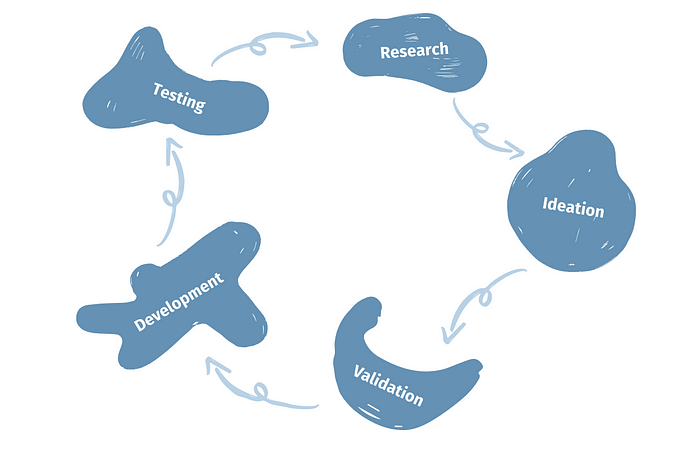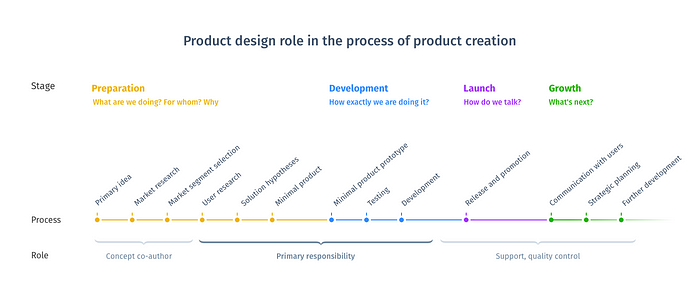Product Designer vs Product Manager: what’s the difference anyway?

I’m teaching product design for quite a time now and noticed students have a poor understanding of the product designer’s job. When I talk about product designer’s expertise, skills and areas of responsibility on every course, I’m asked the same question every time:
“But what’s the difference between a product designer and a product manager?”
This post is my attempt at answering it and the essence of all the information you need to understand the commonalities and differences between these two occupations.
Some people think the product manager position is the next career move for designers. It might be so when a designer wants to change their scope of work dramatically and switch to organizational and management work. But from my perspective, the evolutional step in the design career is the role of the product designer, a specialist with a wide outlook and broad scope of knowledge, different areas of responsibility and a rich toolset not limited to the interface creation.
To explain my angle, let me get back to what actually user experience design is.
What’s user experience?
A few decades ago Don Norman introduced the term “user experience” and a separate job of a product designer in his book “The Design of Everyday Things”. This kind of specialist needed to be involved in all stages of product development. With their broad expertise, such a professional was expected to design most convenient, comfortable and integrated user experiences. But since then the term became overused and simplified to pixel perfection. Eventually, it lost its initial meaning.
Today, for designers occupying positions of user experience designers and UI/UX designers it seems to be obvious what user experience design is. It’s thinking of how the user will interact with the system, and then coming up with and creating a solution, i.e. the interface of a system. Historically, user experience (UX) in most companies has been limited to the creation of user scenarios, wireframes, and design layouts. It’s a fortune if someone in a company knows about design sprint methodology and tries to adapt it to the company’s needs, eventually turning it to several days of developers’ brainstorming over the whiteboard. In the end, UX boils down to the interaction between the user and the interface.
I help students learn the meaning and idea behind this term offered initially by Don Norman. He noticed that the ‘usability’ term is too narrow and relates only to the convenience of the digital system itself. And how about emotions users feel when solving their problem, buying the product and interacting with it? Finally, what aftertaste remains after the user interacted with the product?
I do my best to give designers a real understanding of this term and the overview of necessary skills and expertise zones. Only in this way, they will be able to think out of the box of interface solutions and pixel thinking.

“Today the term “User Experience” has been horribly misused. It is used by people to say “I’m a user experience designer, I design websites, so I design apps” and they have no clues to what they’re doing. UX it’s everything: it’s the way you experience the world, it’s the way you experience your life, that’s the way you experience the service, or — yeah, an app or a computer system — but it’s a system that’s everything.”
— Don Norman
What product designers are doing?
The creation of the product starts with user research. Alone or together with UX researchers, product designers should find out the primary pain points and motivation of potential users, and learn the context of their interaction. Then, they will analyze the received data, create user portraits and try to figure out if the potential product (or the new version of the existing one) has chances to be interesting and useful at all.
Product designers use various research methods and study psychology to better understand people and develop empathy, which is the main weapon in their arsenal. In the end, it is empathy and promoting design thinking as a philosophy and problem-solving methodology that are a guarantee of the product designer’s success.
They also analyze the information received and create documentation (like Product Requirements Document) along with product managers, providing it with necessary sketches, user journey maps, and user portraits. Product designers learn the basics of entrepreneurship, discover business management processes, and study prioritization and resource division practices in the company to finally understand “Why it should have been done yesterday?”. They should communicate with product managers in one language and are allies and co-authors of a unified product concept.
After that, the solution creation process starts. At first, it’s a prototype, the work on an integral story, cooperation with UX writers and developers. Yes, product designers should also understand the principles of content creation for digital products and avoid using ‘lorem ipsum’ (and any other black magic) in their work at any cost.
Then there are various tests, outcome analyses, changes, regular checkups, and coordination with developers. Sure, product designers don’t write code, but they should understand the frameworks and technologies used by developers to keep the work pace quick and effective.
Collaboration with marketers and PR specialists on the promotion stage as well as supplying all necessary assets for pushing the product to the market are also product designers’ areas of responsibility.
And then it all starts in a closed loop.

Considering the inclusiveness of user experience design process, product designers learn not only pixel painting (the skill they usually have perfected already by this time), but also psychology, user research, marketing and entrepreneurship basis, and the principles of creating readable texts. This by no means implies product designers do all of that alone and take direct responsibility for that. No, but they should know how many beans make five in all the above-mentioned areas.
The product designer is a bridge between all teams on all stages of product development and a users’ advocate.
And this is where the same question arises all the time: “Well then what’s the difference between the product manager and the product designer?” Because it’s easy to get a notion that a product designer is a dab hand who should come into every team with its ideas and directions.
Who do product managers do?
Unlike product designers, product managers are business advocates aimed to organize the development process to achieve business goals.
Product managers are directly responsible for market and competitor analysis, product development strategy creation based on collected user problem data, necessary documentation and knowledge base preparation, roadmap creation, teamwork setup, task assignment, and acceptance criteria description.
While product designers research users and their problems, product managers decide on priorities of these problems and assign tasks to developers. Product designers and developers solve problems, and product managers organize their work.
So why there’s even a question about the differences between these two professions and their areas of responsibility in the first place?
Just like product designers, product managers join the development process on every stage. But it is the product manager who is responsible for the process organization, while the product designer’s task is to guarantee the quality and integrity of the solution. At the same time, both experts build their work based on understanding user problems and business goals, and this is where they intersect.
Unlike developers, UX writers or QA engineers, expertise and skills of product designers are much wider and are required on every stage of product development. That’s why one might mistakenly think that product designers might get in conflict with the product managers. In real life, they can only appear as an auxiliary force, by not the product manager’s replacement, as they never manage and organize anything, while managers never solve any product problems directly.
The graph below visualizes what are the responsibilities of product designers, and where their role is not constitutive.

The cooperation of product designers and product managers, their constant interaction and mutual understanding are the keys to creating a successful product or service. Best product managers understand the value of UX, design thinking and the job of product designers, just like product designers recognize the motivations of product managers, their functions and always aim at fruitful cooperation.
Thank you for reading!
If you found this or any of my articles useful, you can support me on my Substack or by buying me a coffee 🤗






